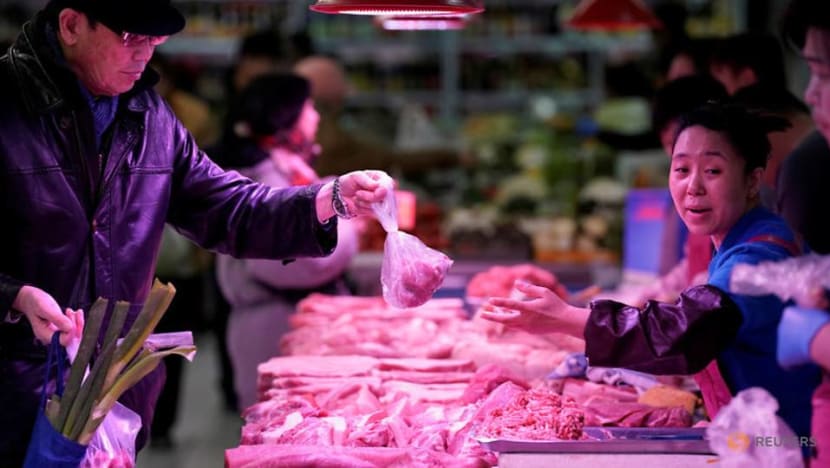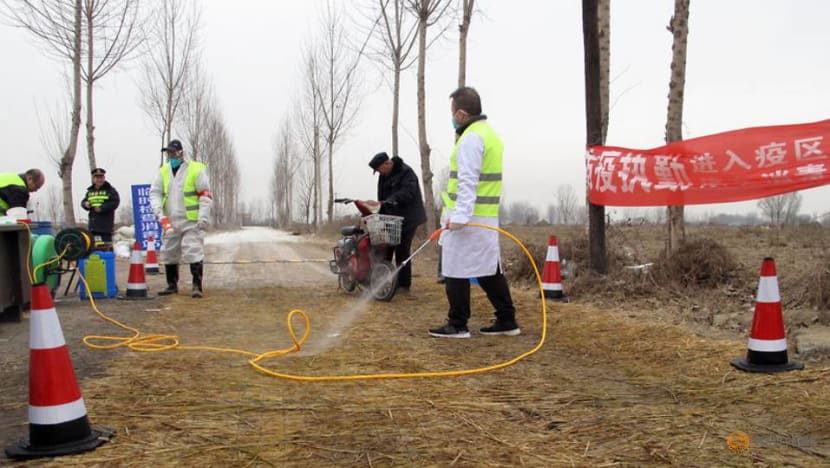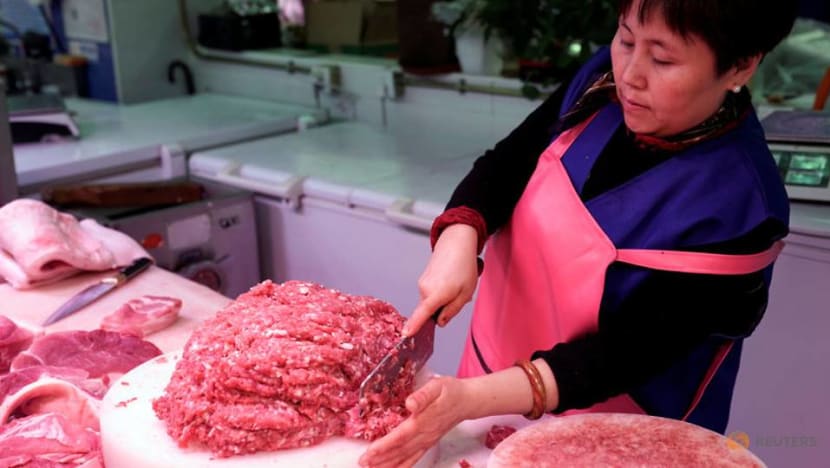commentary Commentary
Commentary: While the swine flu pounds China’s pork industry, meat eaters must stay calm
Some estimates suggest almost four in 10 pigs in China may be culled by the time the country completes its purge of swine flu, says Tom McGregor.

A resident gets pork from a vendor at a market in Beijing, China. (Photo: REUTERS/Jason Lee)
BEIJING: Since the Chinese ushered in the Year of the Pig in 2019, they have had to forego their passion for pork, after the African swine flu was first detected in hog herds in the country last August.
In the immediate aftermath, China’s Ministry of Agriculture and Rural Affairs took proactive measures to curb the spread of the disease, which has been fatal for pigs, but has so far been harmless to humans.
Yet these swift actions have not curtailed the spread of the disease.
As of end-April, swine flu cases have been reported in most provinces in China. Even off the southeast coast of Hainan island, local officials announced last week that six farms had over 500 hogs infected and 146 have died.
The outbreak was initially noticed in Northeast China’s Liaoning Province. After China’s Ministry of Agriculture and Rural Affairs imposed quarantines and introduced culling programmes, official counts by agriculture officials put the number of pigs culled from August 2018 to April 2019 at over a million.
Still, the numbers are likely to be much higher. The Ministry of Agriculture and Rural Affairs disclosed in a report that China had 375 million sows and piglets by the end of March, down from 428 million at the end of last December.
READ: Is Singapore’s decades-long shift away from agriculture about to take a U-turn? A commentary
And on average, China has kept around 430 million pigs, so it appears that more than 50 million pigs were taken out of circulation.
Some experts have even estimated that China’s pork output is likely to fall by 20 to 30 per cent in 2019, with 40 per cent of herds culled.
‘A MOLE HILL OUT OF A MOUNTAIN’
It’s common for the Chinese government to understate matters when they fear full transparency may spark public panic.
A running joke in China is that many Americans are prone to “making a mountain out of a mole hill,” while the Chinese are known for “making a mole hill out of a mountain.”

When Chinese government officials disclosed the detection of the swine flu in the country, many Chinese were concerned that the actual situation might be far worse than what was reported, but few officials wanted to demonstrate visible signs of nervousness.
Beneath the quiet culling of so many pigs, Chinese farmers were issued warnings not to cover up African swine fever. Incentives of 1,200 yuan (US$175) were given to farmers for each pig culled so that incidents would be reported and the disease contained.
THE CHINESE RESPONSE
China’s response to the swine flu may have been muted, but many Chinese have already altered their diets in a dramatic fashion.
If dire forecasts do prove accurate and 200 million pigs will be culled before the infection gets wiped out, you can anticipate pork prices to soar. In the first week of April, pork prices rose by 36 per cent compared to the same period a year earlier.
“Pork output will fall and supply will be light,” Wang Junxun, deputy chief of the veterinary bureau of the Ministry of Agriculture & Rural Affairs, was quoted as saying in media reports. “The price of live hogs will hit new historical highs in the fourth quarter of this year.”
The Chinese are cost-conscious consumers. When pork prices surged on occasion, many have adapted by eating other types of meat.
Additionally, many schools nationwide have stopped serving pork, while many large companies and state-owned enterprises (SOEs) that offer subsidised meals for employees have stopped cooking pork at their cafeterias.

More have switched to beef, lamb and chicken for protein. Many restaurants have made adjustments to cut out pork dishes from their menus.
READ: Typhoon Mangkhut's destruction of rice, corn and fish, a commentary
A PRIME MARKET FOR MEAT EXPORTERS
Another beloved phrase in China is “crisis means opportunity.” Meat-producing countries might see this as an opportunity to fill the pork gap.
Already, Indian meat producers have received more orders from their neighbouring country, where pork and buffalo meat are sold at relatively low prices. The close proximity to Chinese ports and inspections sites also make India a choice source of pork and other meats.
India’s Agriculture and Processed Food Products Export Development Authority has agreed to accelerate processing procedures for meat traders.
“It’s a good opportunity for Indian companies, considering that China is the biggest consumer of pork meat in the world,” Arindon Hazarika, head of sales and marketing at Aroha Foods, told the Economic Times. “They are currently short by 3 to 5 per cent of their domestic demand.”

Meanwhile, Australian, Latin-American and North American beef exporters are also eyeing higher sales in China but challenges to greater trade remain.
Canada, a huge exporter of beef, is facing a freeze in bilateral relations with Beijing after Huawei’s Chief Financial Officer Meng Wanzhou was arrested at the Vancouver Airport last December.
American ranchers must also wait for President Donald J Trump and Chinese President Xi Jinping to sign a US-China trade agreement before they can deliver beef to the world’s second-largest economy.
However, White House officials have given hints that the two sides are reaching a near conclusion to signing a deal.
READ: All this China bashing is an outgrowth of an insecure US, a commentary
Although many Chinese love to eat pork, they have weathered the swine flu epidemic in a calm manner, and have altered their diets.
Eventually, the infection will die down, but it may take a year or so before life goes back to normal.
And when pork dishes do return to dinner tables, the Chinese will be more than ready to relive their love affair for pork.
Tom McGregor is a commentator on Asia-Pacific affairs based in Beijing.















